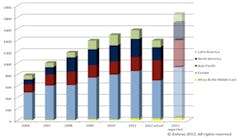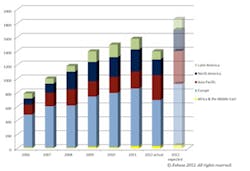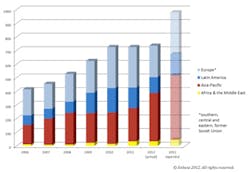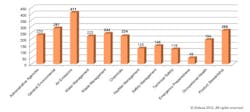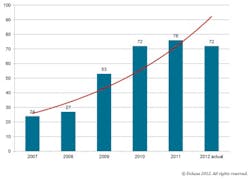It’s that crucial time of the year, when most companies around the globe make their best efforts in planning for 2013. Goals are set, projects are outlined, deadlines are established and perhaps most importantly, next year’s budgets are made. In order to improve or maintain your current program, you often have to justify its importance with some concrete figures. Enhesa Inc., a global EHS compliance assurance firm, is tracking some global EHS trends that may help you make determine the budget you’ll need in 2013 to achieve your EHS goals.
What is the current global regulatory climate? Has there been an increase in regulations worldwide? What does the future hold? What’s the growth by world region or by subject?
These are the questions you’ll need answers to as you plan for the upcoming year’s EHS program and corresponding budgets.
Let’s start by looking at the overall number of new laws and regulations worldwide as of Oct. 1, 2012, and compare them to what has been tracked in the past. Figure 1 demonstrates the new laws and regulations adopted by world region within the calendar year. You can begin to see how the global numbers of 2012 (currently 1,397) are reaching levels that will surpass the figures in 2011, as projected by Enhesa in the “2012 expected” column.
Coincidentally, in a past 2012 Enhesa survey, EHS managers around the world indicated that these were the most difficult global regions to identify regulations. This may be due to cross-cultural communication issues or the inability to access regulatory content easily in a given country. The growth in these regions stresses the need to have a team of experts that understands the EHS regulatory culture and has access to country-specific resources for regulatory information.
In Figure 1, you also may note that Europe has been on a consistently high-growth trend, which suggests that the resources for managing compliance in the region should continue to be strongly supported. While finding the right resources to identify and understand regulations is a major challenge to Asia Pacific, Africa and the Middle East regions, the challenge in Europe is to effectively monitor the rapid growth, and feasibly digest the regulation.
Emerging Markets
As the economic importance in what is considered emerging markets continues to rise, it also is intriguing to take a focused review of the EHS laws and regulations adopted in emerging markets and developing economies. In Figure 2, the main difference you’ll find from the previous chart is the total for Europe. In that category, Western European countries considered as “developed” were removed. Emerging economies in Southern, Central and Eastern Europe were kept.
Current Proposals Pending
As a global EHS manager, it is likely that you are interested in what the future holds, and which subject areas within EHS are growing more rapidly than others. Understanding this concern, Enhesa examined the current EHS proposals pending worldwide and counted over 2,500 outstanding regulatory proposals and initiatives that likely will result in new regulatory obligations for business in the upcoming years.
In Figure 3, you’ll find the breakdown of EHS proposals by Enhesa’s standardized thematic headings. Air emissions (incl. energy efficiency and climate change), general environmental, product stewardship, waste and chemicals management are the areas where most new legislation and policy is being developed.
Enforcement
It’s been argued before that the growth of regulations has an impact only if those regulations are enforced. Therefore, it also is important to monitor the increase of laws and regulations worldwide that solely were dedicated to the purpose of strengthening enforcement power. In the past 12 months, 143 laws and regulations were adopted to strengthen the enforcement provisions of environmental law.
Furthermore, let’s look at major global EHS enforcement cases that are relevant to large businesses. By the beginning of October 2012, there were over 72 cases where companies were prosecuted for violating EHS laws and regulations (Figure 4).
What to Consider Going Forward
The good news is that the numbers are working in your favor to justify the resources you need to manage the ever-increasing laws and regulations. The “not-so-lovely” news is that the figures don’t make your job as an EHS manager any easier to perform.
These statistics should drive you to conclude that countries not only are increasing the number of EHS-related regulations, but also concentrating on some areas with EHS more than others. Additionally, the expansion of enforcement practices increases the overall risk of noncompliance findings.
Consider an approach that helps you track regulation down to a local level, allows you to build a strong management system to account for all emerging issues and has a standardized methodology that you can utilize across all of your global facilities.
Virginia Shaffer is the senior marketing and sales coordinator at Enhesa and is based in Washington, DC. She has over 5 years of professional experience in business development and trend analysis. Virginia currently administers a successful webinar program at Enhesa, and is the editor of Enhesa’s bimonthly magazine, The Flash, which is viewed by thousands of EHS managers worldwide. She holds a B.A. in International Relations, concentrated in Economics and focused in European and Asian Regional Studies.
